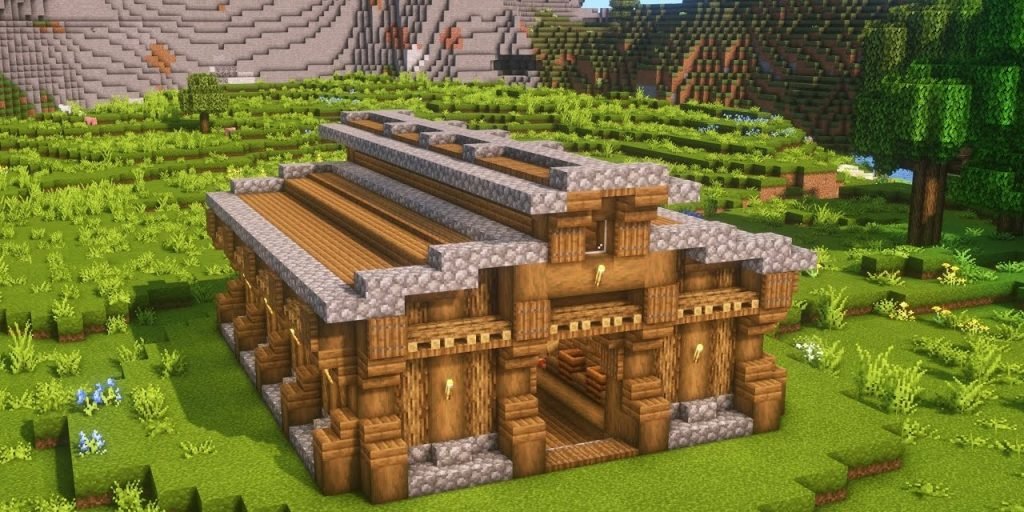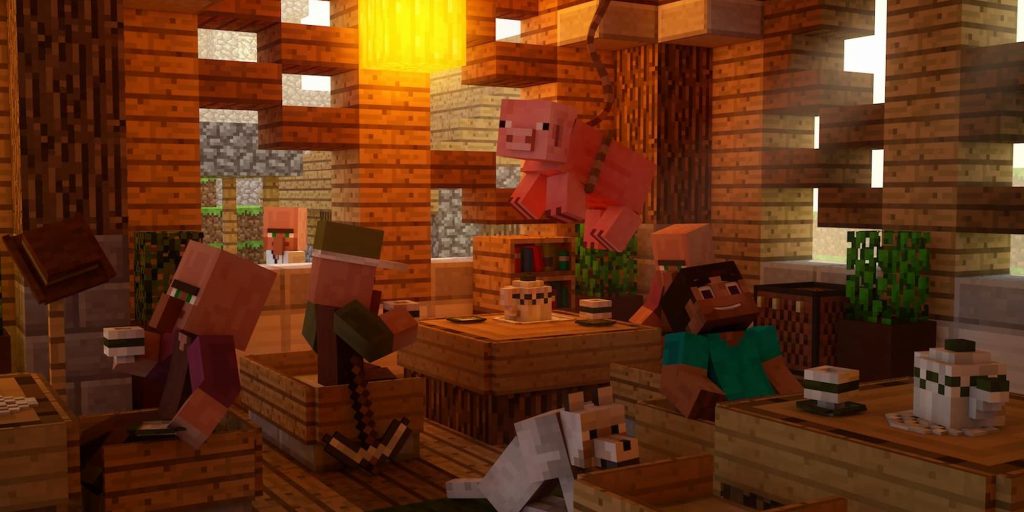When seeking absolute power and maximum efficiency in a Minecraft world, you should race to building a trading hall as early as possible. There are, however, many requirements for building and using a trading hall effectively. It is a relatively large project and not for the faint of heart! Additionally, the size and duration of this project depends largely on how many trade options you desire. However, if you’re up to the task, there isn’t an enchantment book, decoration, or food item that will be out of your reach.
Step One – Build A Villager Farm
The first step in your journey to a trading hall should be building a villager farm. This will require two villagers, three beds, lots of potatoes, and a home for the villagers (make sure that they are effectively trapped inside and will not go wandering away–they like to do that).
Tip: While villagers are capable of opening doors, they cannot open gates or trap doors, making these wonderful options for getting in and out of the farm.
Without a villager farm, staffing your trading hall will be nearly impossible. Transporting each villager directly from a village will take copious amounts of time, and finding a sufficient supply of naturally occurring villagers will be an even greater task. Once your villager farm is built, however, you will be well on your way to having an operational trading hall.
Step Two – Establish Your Trading Hall
While the population of your villager farm expands, you can begin transporting the villagers from the farm and to your trading hall. At this point, you will need to have built the trading hall. Other than a few requirements and recommendations, there are no rules to building the structure of the hall itself. It is your decision whether you want to erect a large and opulent structure or a rudimentary construction with the minimum requirements for functionality. Beyond this short list of features, the design of the trading hall is entirely up to you!
- Individual cells from which the villagers can not escape.
- Work blocks to assign each villager a job.
- Plenty of light sources to protect the villagers from hostile mobs.
- An expandable design for the trading hall structure to allow for more cells and villagers to be added at will.
A very common and effective blueprint for trading halls possess rows of individual cells to be occupied by the villagers. Each cell will also need to house a work block that will assign the corresponding villager its job, allowing it to trade.
Remember to add plenty of light sources to the build, dispelling any dark areas in which hostile mobs can spawn. It would also be wise to construct your trading hall in such a way that it is easily expandable. You never know when you might want to add more villagers in order to widen your selection of available trades.


Step Three – Assigning Jobs For Trading
Once a villager has been successfully relocated to a cell in the trading hall and assigned a job, you will notice that it requires emeralds or a handful of items, sometimes both, to complete the trade. Emeralds are not particularly easy to come by in Minecraft, and trying to amass sufficient stores of emeralds through standard mining techniques is not ideal. Librarian villagers will often trade you emeralds in exchange for paper. The quickest way of developing a large collection of paper is by building an automated sugar cane farm.
There are quite a few jobs that can be assigned to villagers, and each villager can trade a large number of items. Here is a list of each villager job, the work block that assigns the job, and the items that they can trade.
| Villager Job | Work Block | Items For Trade |
| Butcher | Smoker | Emerald, Cooked Porkchop, Cooked Chicken, and Rabbit Stew |
| Armorer | Blast Furnace | Emerald, Iron Armor, Chainmail Armor, and Diamond Armor |
| Cartographer | Cartography Table | Emerald, Empty Map, Ocean Explorer Map, Woodland Explorer Map, Item Frame, Banners, and Globe Banner Pattern |
| Cleric | Brewing Stand | Emerald, Red Stone, Lapis Lazuli, Glow Stone, Ender Pearl, and Bottle O’ Enchanting |
| Farmer | Composter | Emerald, Bread, Pumpkin Pie, Apple, Cookie, Cake, Suspicious Stew, Golden Carrot, and Glistering Melon Slice |
| Fisherman | Barrel | Emerald, Cooked Cod, Bucket of Cod, Cooked Salmon, Campfire, and Enchanted Fishing Rod |
| Fletcher | Fletching table | Emerald, Arrow, Flint, Bow, Crossbow, Enchanted Bow, Enchanted Crossbow, and Tipped Arrows |
| Leather Worker | Cauldron | Leather Pants, Leather Tunic, Leather Cap, Leather Boots, Leather Horse Armor, and Saddle |
| Librarian | Lectern | Emerald, Enchanted Books, Bookshelf, Lantern, Glass, Clock, Compass, and Name Tag |
| Mason | Stonecutter | Emerald, Brick, Chiseled Stone Brick, Polished Andesite, Polished Granite, Polished Diorite, Dripstone Block, Colored Terracotta, Glazed Terracotta, Quartz Pillar, and Block of Quartz |
| Shepherd | Loom | Emerald, Sheers, Wool, Carpet, Bed, Banner, and Painting |
| Toolsmith | Smithing Table | Emerald, Stone Axe, Stone Pickaxe, Stone Shovel, Stone Hoe, Bell, Iron Axe, Iron Pickaxe, Iron Shovel, Iron Hoe, Diamond Axe, Diamond Pickaxe, Diamond Shovel, and Diamond Hoe |
| Weaponsmith | Grindstone | Emerald, Iron Axe, Iron Sword, Bell, Diamond Axe, and Diamond Sword |


If you are in search of a trade for a particular item, assign the corresponding work block to a villager in your trading hall. If the item you desire isn’t initially displayed in the villager’s trade options, don’t worry–all you must do is destroy and replace the work block to reset the villager’s trade menu. It might take some time, but you should eventually be able to find the desired trade. Once the villager is offering the trade you seek, you can go ahead and complete the trade. This will lock the villager’s trade menu, preventing it from changing. If you don’t trade with the villager, effectively locking his trade menu, his offers will change over time, and you could lose the desired item. Remember, also, that for many items of high value to be offered, the villagers need to be upgraded. Villagers can be upgraded by simply completing trades with them.
With such a versatile trading hall and a healthy supply of emeralds, the Ender Dragon stands no chance!
- amazon prime gaming
- axie infinity
- Casino Games
- coingenius
- Dualshokers
- EA Sports
- Evil Geniuses
- Gaming
- gaming headset
- gaming pc
- Guides
- madden nfl
- Minecraft
- Nintendo
- Online casino games
- pc games
- plato
- plato ai
- plato data intelligence
- plato game
- plato gaming
- platodata
- platogaming
- playstation
- prime gaming
- Team SoloMid
- xbox
- zephyrnet












